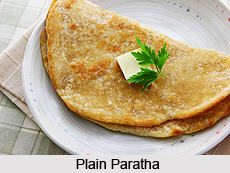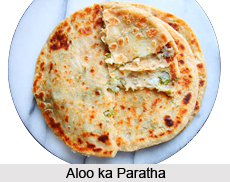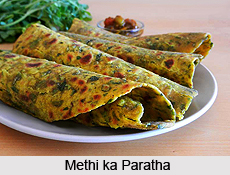 Paratha is a flatbread popularly preferred as breakfast, lunch, evening and dinner food item in various parts of India. The term "Paratha" is a merger of two words "Parat" and "Atta" which literally means layers of cooked dough. It originated in the Indian Subcontinent and is still quite prevalent throughout the area.
Paratha is a flatbread popularly preferred as breakfast, lunch, evening and dinner food item in various parts of India. The term "Paratha" is a merger of two words "Parat" and "Atta" which literally means layers of cooked dough. It originated in the Indian Subcontinent and is still quite prevalent throughout the area.
The paratha can be of varied shapes such as round, heptagonal, square, or triangular. It is made by pan frying whole wheat dough on a tawa. The parantha dough usually contains ghee or cooking oil which is also layered on the freshly prepared paratha. It is prepared by stuffing different vegetables to provide a distinct flavour like there is "Aloo ka Paratha" (stuffed with potato), "Pea"s Paratha" (stuffed with peas), "Paneer Paratha" (stuffed with paneer), "Gobi ka Paratha" (stuffed with cauliflower/cabbage) etc. However, the plain paratha which is consumed as an everyday food item usually comprises of whole-wheat flour and cooking oil.
A paratha can be served by teaming up with vegetable curry, chutney, pickle or yogurt as per choice. Those who treat paratha as a breakfast and evening food item prefer to roll it into a tube and consume with tea, often dipping the parantha. It can also be eaten simply with a pat of butter spread on top.
1. Plain Paratha Ingredients:
•4 cups of whole-wheat flour
•2 cups of water
•1/4th tsp of salt
•Small bowl of sunflower oil
 Method of Preparing Plain Paratha:
Method of Preparing Plain Paratha:
•First of all, mix flour, oil and salt thoroughly in a deep bowl.
•Then add water and knead the flour for five minutes to form smooth dough. Keep it aside for 15 minutes.
•Divide the dough into small size balls. Flatten each ball into small circle. Spread onto the dough few drops of oil and fold it to form a semi circle. Again add few drops of oil in this semi circle dough and fold once again to form a quarter of a circle.
•Heat the tawa and when tawa is hot, place the rolled out dough on it. Leave for half a minute and turn the other side.
•The paratha will swell up and at this time add a teaspoon of oil on the top of the paratha and turn over. When the paratha turns up, once again pour oil and turn the other side.
•When it is brown on both sides, remove from tawa and serve hot.
2. Aloo ka Paratha Ingredients:
•1 and 1/2 cup Wheat Flour
•2 medium Potatoes, boiled and peeled
•4 tbsp finely chopped Coriander Leaves
•1 tsp Lemon Juice
•1 tsp Sugar
•2 Green Chilli, finely chopped
•1 tsp Garam Masala
•1 tsp Red Chilli Powder
•1 tsp grated Ginger
•Butter
•2 tbsp Oil
•Salt to taste
•Water
Method of Preparing Aloo ka Paratha:
•First prepare dough by taking wheat flour, 1 teaspoon oil and salt in a small bowl. Add water in small quantities and knead smooth and soft dough. Grease its surface with 1/2 teaspoon oil, cover it with clean muslin cloth and set aside for 15 minutes.
•Now, prepare aloo paratha stuffing by mixing mashed potatoes, chopped green chillies, red chilli powder, grated ginger, garam masala, sugar, lemon juice and salt in a bowl. Mix all ingredients properly.
•Divide stuffing into 6 equal parts and give them a shape of ball. Divide prepared dough into 6 equal parts, give them a round shape and press a little to flatten.
•Take one dough ball and coat it with dry wheat flour on both sides. Put it on rolling board and roll it out into a circle. Put one portion of stuffing in the center of it.
•Wrap stuffing ball by lifting all sides of rolled circle towards top, seal the edges and again give it a round ball shape.
•Gently press stuffed ball on rolling board and dust some dry flour over it and roll it out into a circle.
•Heat a pan and place the paratha on it.
•Cook each side with little oil until brown spots appear on both sides.

3. Methi ka Paratha Ingredients:
•1 cup Wheat Flour
•1/2 cup Fenugreek Leaves finely chopped
•2 Garlic Cloves
•1 Green Chilli
•1/4 tsp Cumin Seeds
•1/8 tsp Turmeric Powder
•Salt to taste
•Oil
Method of Preparing Aloo ka Paratha:
•Crush the garlic and green chilli into a coarse paste.
•Heat 2 tsp of oil in a pan. Add the cumin seeds and fry for a few seconds.
•Then add the ginger garlic paste and fry for a few seconds.
•Add the chopped fenugreek leaves and turmeric powder and fry for a couple for minutes or until it wilts.
•Turn off the flame and let it cool.
•Take the flour, salt and fenugreek mixture in a bowl and combine.
•Make smooth and pliable dough by adding water in small quantities. Knead it well.
•Cover the dough and keep it aside for 30 minutes.
•Divide the dough into 5 equal portions.
•Roll each ball into a circle.
•Heat a pan and place the paratha on it.
•Cook each side with little oil until brown spots appear on both sides.




















